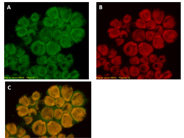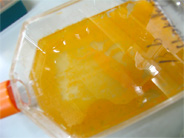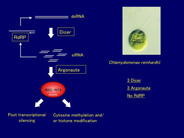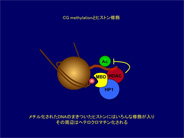Project 1. ナノ粒子による細胞死誘導機序の解析
樹脂製ポリマーの集合体が作るナノ粒子が、多様な微細藻に対して迅速に細胞死を誘導するメカニズムについて興味を持っています。この機序の解明のために単細胞緑藻のクラミドモナスを用いて、微細形態の変化や生理学的なアプローチ、更に遺伝子発現の変化や突然変異体の解析で迫ろうとしています。シアノアクリレート ナノ粒子とポリスチレン系ナノ粒子を主に用いています。これまでの研究から、細胞死誘導にはナノ粒子が細胞表面を覆う必要はなく、ナノ粒子の細胞壁への衝突と、それに続く細胞質膜への接触または細胞質内への侵入によって引き起こされた活性酸素種(ROS)の蓄積が細胞死の直接の原因であることが分かっています。
一方、陸上植物や一部の緑藻では細胞死を誘導されない事も分かりました。またシアノアクリレート粒子は、グラム陰性菌には無効ですが、グラム陽性細菌に対して特異的に溶菌を引き起こすことも知られています。このような、ナノ粒子暴露に対する反応の差が何に起因するのかを明らかにしたい。
Project 1. Analysis of the mechanism how nanoparticle induces cell death: We are interested in the mechanism how resin nanoparticle acutely induces cell death to various kinds of micro algae. To explore this mechanism, we will use morphological and physiological approaches, and also molecular genetic approaches such as differential gene expression analysis or mutagenesis. Nanoparticles made of polymers of cyanoacrylate and polystyrene are mainly used. We have shown that covering cell surface by nanoparticle is not necessary to induce cell mortality, while accumulation of ROS induced by nanoparticle collision on the cell surface followed by invasion of it into cytosol is the direct cause of cell death.
Cyanoacrylate nanoparticle cannot induce cell mortality to land plants and some micro green algae, while it can induce cell lysis to Gram positive bacteria but not to Gram negative ones. We would like to make it clear what is the contributory cause of such different responses to nanoparticle exposure.
Project 2. 微細藻類を用いた効率的な炭化水素生産系の構築
バイオエネルギーとしては、澱粉やセルロースを発酵させてエタノールを生産するというシステムが第1世代であり、すでに実用化されつつある。第2世代のバイオエネルギーは、藻類などが貯蔵物質として細胞内に蓄える炭化水素を石油代替物として利用することを目指している。これを実現するためには、利用し易い性質を持つ炭化水素を藻類に効率良く作らせる必要がある。遺伝子工学を駆使した藻類の分子育種により、それを実現させる。微細藻類の中でも、ボトリオコッカスは炭化水素生産藻として優れた特性を持った群体性の緑藻であり、注目される。
Project 2. Development of an efficient hydrocarbon producing system in algae: Ethanol is a first-generation biofuel generated from starch or cellulose by fermentation, while hydrocarbons that are accumulated in algal cells are second-generation biofuels. We intend to develop a system in which useful hydrocarbons are produced efficiently by algae as an alternative energy resource to oil. For this, we will breed high-quality algae using molecular genetics. Botryococcus braunii is a colony producing green alga that has the desirable characteristics for this purpose.




